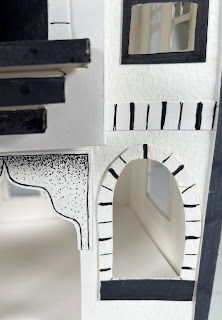Historic Architecture
Model #1: Villa Zorayda and Lightner Museum
Full View:
Villa Lightner
Bristol paper, wood glue, permanent marker, masking tape, staples
9'' x 3'' x 4''
View #2
View #3
Details:
Detail #1
Detail #2
Design Elements:
In order to incorporate the architecture, design, and structure of the Villa Zorayda and The Lightner Museum, the artist combined multiple elements. The entryway of my structure is similar to the Villa Zorayda; the pillars and pointed to the arch above the doorway, and battlements were also incorporated (design elements going around the top of the structure) from the Villa as well. Inspiration came from the windows of the Lightner Museum for my model. On the side of the museum, there is a triple-arched window, which was included in the piece on the back. Both the Villa Zorayda and The Lightner included Spanish-style architecture that was used for design elements of the model. The other windows on the Lightner are a combination of standard boxy windows and arches, which the artist made an example of as well.
Villa Zorayda:
History of Villa Zorayda:
Villa Zoryada was built by Franklin W. Smith in 1833 as his winter home, it was the first building in Florida to be made out of concrete and it caught the attention of Henry Flagler who used the method of pouring cement and adding crushed coquina rocks for his other buildings, the Ponce de Leon Hotel and the Alcazar Hotel. After about 20 years the home was turned into a social club for the elite. In 1913 the property was sold to Abraham Mussallem, in the 1920s it became a gambling casino/speakeasy, and in the later 1920's the Mussallem family lived in the residence. After several years in 1933, the family realized the important history behind the building and opened it as the Villa Zoryada Museum we know today.
The Lightner Museum:
History of The Lightner Museum:
The Lightner Museum was built by Henry Flagler in 1888 as the Hotel Alcazar. It was built as an entertainment complex for the famous Ponce de Leon Hotel across the street, it had indoor swimming pools, a grande ballroom, tennis courts, etc. It closed its doors in 1930 due to an economic decline and remained closed until Otto C. Lightner purchased it in 1947 as a place to house his collection of artifacts. The museum has been open to the public since January of 1948, and in 1950 the city of Saint Augustine gained ownership after Otto passed away due to cancer. Many different collections and exhibits have been added since its opening.
Model #2: Casa Monica and Lightner Museum
Full View:
The Monica Lightner Hotel
Bristol paper, wood glue, permanent marker, masking tape, staples
8'' x 12'' x 3''
Design Elements:
In order to incorporate the architecture, design, and structure of the Casa Monica and The Lightner Museum, the artist combined multiple elements. The rounded structure in the middle of the model is similar to the one on the side of the Lightner Museum, the slim windows below the balcony are also inspired by the Lightner. The Casa Monica served as a model for the balconies, the structure as a whole has a castle feel, which the artist tried to emulate. Both the Lightner and the Casa Monica are very extravagant structures used for some of the richest to vacation in today's time and 100 years ago.
detailing below the battlements on the Casa Monica was also utilized in the model.
detailing below the battlements on the Casa Monica was also utilized in the model.
The Lightner Museum:
History of The Lightner Museum:
The Lightner Museum was built by Henry Flagler in 1888 as the Hotel Alcazar. It was built as an entertainment complex for the famous Ponce de Leon Hotel across the street, it had indoor swimming pools, a grande ballroom, tennis courts, etc. It closed its doors in 1930 due to an economic decline and remained closed until Otto C. Lightner purchased it in 1947 as a place to house his collection of artifacts. The museum has been open to the public since January of 1948, and in 1950 the city of Saint Augustine gained ownership after Otto passed away due to cancer. Many different collections and exhibits have been added since its opening.
Casa Monica:
History of the Casa Monica:
The Casa Monica was built by Franklin W. Smith in 1888 but soon after he almost made the hotel go bankrupt. It was sold to Henry Flagler who was able to bring it back to success, he renamed it the Cordova Hotel, and eventually, he even connected Hotel Alcazar and the Cordova, which had a new name Alcazar Annex. In the 1930's due to the Great Depression, the hotel closed down, it sat abandoned for about 30 years until the St. Johns County Commission voted to use it as a courthouse. In 1997 Richard Kessler purchased the building from the county and in 1999 and reopened its doors as the Casa Monica Hotel.





















No comments:
Post a Comment